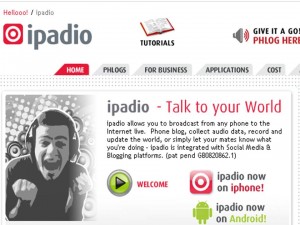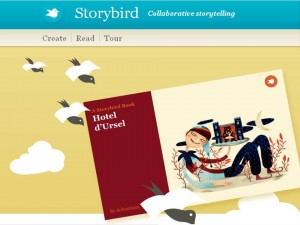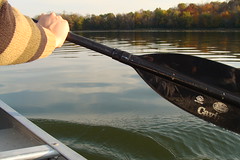DEN Virtual Conference attendees were wowed in session two by Porter Palmer’s Out of This World Ideas for Showcasing Student Work. She directed us to research from Chris Weber’s Publishing with Students: A Comprehensive Guide, especially his information on web-based publishing for students. She pointed out that  research shows grading writing discourages students from taking risks, while publishing encourages them to take risks. Porter collected all of her links for the presentation in Live Binders, a great way to keep presentation resources organized neatly. (While looking at LiveBinders I happened across another binder of Technology Integration Resources for library and media specialists by mnpsil. Definitely going back to that one later!)
research shows grading writing discourages students from taking risks, while publishing encourages them to take risks. Porter collected all of her links for the presentation in Live Binders, a great way to keep presentation resources organized neatly. (While looking at LiveBinders I happened across another binder of Technology Integration Resources for library and media specialists by mnpsil. Definitely going back to that one later!)
 First on Porter’s list was Posterous. This tool lets you post video, audio, and image files, as well as text. You can also include documents and even embed Google Maps. You can set up the page yourself or email your files to them and it is turned into a page for you. There is also a handy bookmarklet. Note: Since Posterous accounts are for ages 13 and older, elementary teachers would need to post students’ work for them.
First on Porter’s list was Posterous. This tool lets you post video, audio, and image files, as well as text. You can also include documents and even embed Google Maps. You can set up the page yourself or email your files to them and it is turned into a page for you. There is also a handy bookmarklet. Note: Since Posterous accounts are for ages 13 and older, elementary teachers would need to post students’ work for them.
 She also demonstrated how teachers can use wikis such as wikispaces or PBworks for classroom pages and to embed student videos or store documents. Speaking of wikis, Porter also showed how students can actually become serious content creators by contributing to Wikipedia after they research a topic. Another site to which students can contribute is World 66-The Travel Guide, a great resource for information about various travel destinations. Each entry is editable by anyone else. Note: It is not clear what editorial checks occur on these pages, however, and their Terms of Service do not mention age, just provide a link to content filtering tools that parents can use to block harmful content.
She also demonstrated how teachers can use wikis such as wikispaces or PBworks for classroom pages and to embed student videos or store documents. Speaking of wikis, Porter also showed how students can actually become serious content creators by contributing to Wikipedia after they research a topic. Another site to which students can contribute is World 66-The Travel Guide, a great resource for information about various travel destinations. Each entry is editable by anyone else. Note: It is not clear what editorial checks occur on these pages, however, and their Terms of Service do not mention age, just provide a link to content filtering tools that parents can use to block harmful content.
 Next on the menu was SlideShare, a way for PowerPoint presentations to be shared online. Use the embed code to place into wikis, blog, glogs, anywhere you can embed. You can even turn your slides into a slidecast with audio added to the slides. Note: Terms of Service indicate the site is not to be used by anyone under the age of 13. SchoolTube was also mentioned as a site for sharing student and teacher created videos.
Next on the menu was SlideShare, a way for PowerPoint presentations to be shared online. Use the embed code to place into wikis, blog, glogs, anywhere you can embed. You can even turn your slides into a slidecast with audio added to the slides. Note: Terms of Service indicate the site is not to be used by anyone under the age of 13. SchoolTube was also mentioned as a site for sharing student and teacher created videos.
 Other sites on Porter’s list included the ever-popular Glogster EDU, which she termed the “new book report site” indicating just one of its many uses in the classroom as a digital poster. For easy voice recording over the phone, she pointed us to ipadio. An example of its use might be students creating a voice recording for a foreign language class. Note: In order for a student to call in and create a “phlog”, they need to register by providing their first and last names, email addresses, and the phone numbers they will use to call in, so this is definitely not for elementary school students. Perhaps a work around could be the teacher being the account holder and using the school number for calling in, allowing younger students to record voices in that manner. These phlogs are embeddable in blogs, wikis, etc.
Other sites on Porter’s list included the ever-popular Glogster EDU, which she termed the “new book report site” indicating just one of its many uses in the classroom as a digital poster. For easy voice recording over the phone, she pointed us to ipadio. An example of its use might be students creating a voice recording for a foreign language class. Note: In order for a student to call in and create a “phlog”, they need to register by providing their first and last names, email addresses, and the phone numbers they will use to call in, so this is definitely not for elementary school students. Perhaps a work around could be the teacher being the account holder and using the school number for calling in, allowing younger students to record voices in that manner. These phlogs are embeddable in blogs, wikis, etc.
 With Storybird, students can choose beautiful illustrations from a variety of artists and compose an original story. Teachers can create classes of students and there is an option to collaborate with schools around the world. Storybirds can be set to public or private and an embed code is provided.
With Storybird, students can choose beautiful illustrations from a variety of artists and compose an original story. Teachers can create classes of students and there is an option to collaborate with schools around the world. Storybirds can be set to public or private and an embed code is provided.
 ToonDoo is a site where users can create comic strips with existing graphics. Note: Terms of Service say “ToonDoo will only provide the Service to “persons and entities who can form legally binding and enforceable contracts under applicable law.” Since there may be objectionable material created by some users of the site, caution is advised. Someone in the chat offered the suggestion of Toondoospaces, which is private and for educational use, but only provides a 15-day free trial before you need to select a payment plan. Xtranormal, a way to turn a typed script into an animated video clip, has two versions. The online version clearly states it is not for under 13 years of age, and in fact anyone who is a “minor” needs parents to register for them. The only option for schools seems to be the downloadable version known as “State”, which is still in Beta and does not yet seem to have a lot of options, but may be worth experimenting with.
ToonDoo is a site where users can create comic strips with existing graphics. Note: Terms of Service say “ToonDoo will only provide the Service to “persons and entities who can form legally binding and enforceable contracts under applicable law.” Since there may be objectionable material created by some users of the site, caution is advised. Someone in the chat offered the suggestion of Toondoospaces, which is private and for educational use, but only provides a 15-day free trial before you need to select a payment plan. Xtranormal, a way to turn a typed script into an animated video clip, has two versions. The online version clearly states it is not for under 13 years of age, and in fact anyone who is a “minor” needs parents to register for them. The only option for schools seems to be the downloadable version known as “State”, which is still in Beta and does not yet seem to have a lot of options, but may be worth experimenting with.
All of Porter’s links used in her presentation can be found in her LiveBinder. Be sure to visit the archived webinar when it becomes available on the DEN site. Thanks, Porter, for a jam-packed presentation of ways to showcase our students’ learning!
 interaction with students around the world and develop cultural understanding and global awareness. The student’s individual blog page can also be a place to showcase his or her creative projects. Through this challenge my students have had the opportunity to participate in
interaction with students around the world and develop cultural understanding and global awareness. The student’s individual blog page can also be a place to showcase his or her creative projects. Through this challenge my students have had the opportunity to participate in 
 Although there are many other wonderful tools that could fill a book (and many writers have done just that) the tools that I have mentioned above have become rather standard fare in today’s classrooms. These basics can be enhanced with tools that showcase student work and allow diverse groups to come together to collaborate and appreciate each other’s similarities and differences. These tools have helped and continue to help both teachers and students navigate the 21st century global seas. We just need to keep paddling.
Although there are many other wonderful tools that could fill a book (and many writers have done just that) the tools that I have mentioned above have become rather standard fare in today’s classrooms. These basics can be enhanced with tools that showcase student work and allow diverse groups to come together to collaborate and appreciate each other’s similarities and differences. These tools have helped and continue to help both teachers and students navigate the 21st century global seas. We just need to keep paddling.